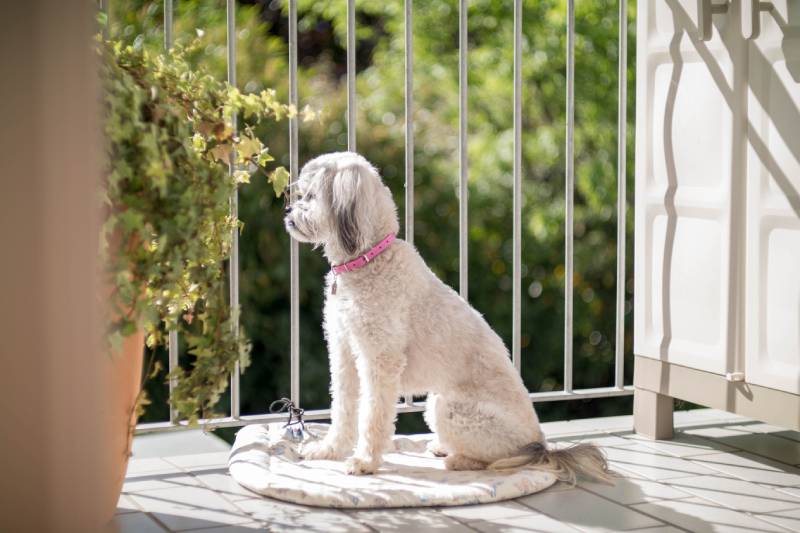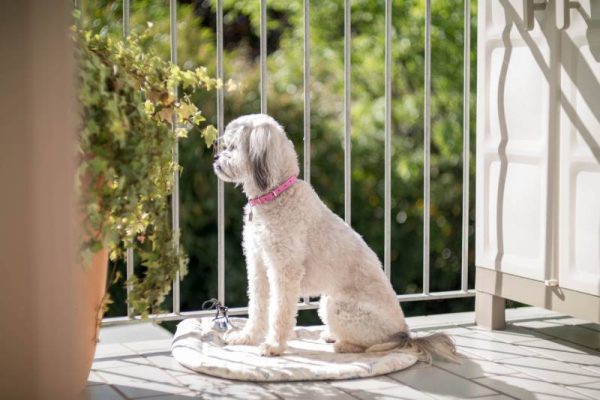Some may think that having a balcony and a dog isn’t a good idea. While there is the possibility of your dog falling and injuring itself, there are many ways you can pet-proof your balcony to keep your dog safe and enjoy your balcony as a family. Aside from always supervising your dog on the balcony, here are 10 great tips on how to dog-proof your balcony railings.
The 10 Tips on How to Dog Proof a Balcony
1. Netting for Your Balcony
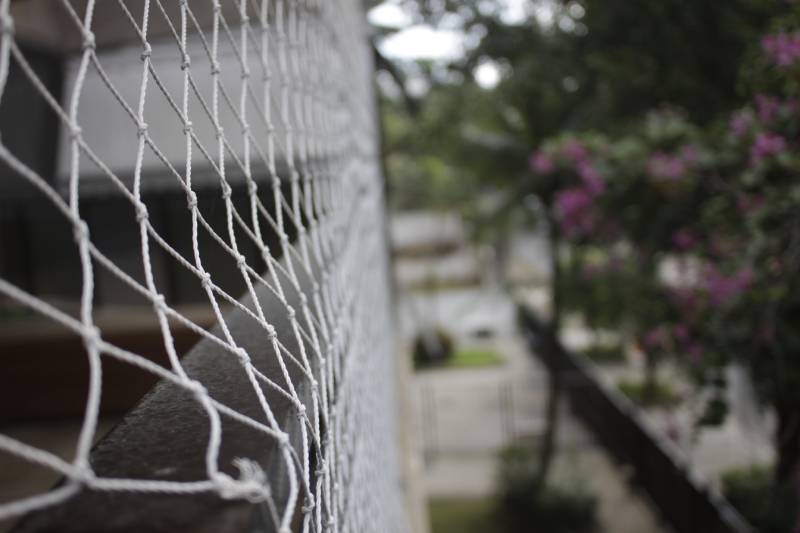
One of the easiest ways to dog-proof a balcony is by putting up some netting around the railing to essentially block the bars from being able to be squeezed through by your dog. This is an easy and cheap solution for many pet owners, but owners of strong dogs or ones that love to chew may not think that netting will be able to keep their dog from getting through, so they may need to think about something more substantial or more permanent to keep their dogs safe on the balcony.
You can easily find netting in any hardware store, and you can cut it to size and attach it to your railings with plenty of zip ties. However, check it daily for any damage on the netting, as even the strongest netting will wear down eventually.
- Cheap
- Easy to install
- Weatherproof
- Not suitable for strong dogs or dogs who like to chew
2. Plexiglass or Strong, Shatterproof Glass Panels
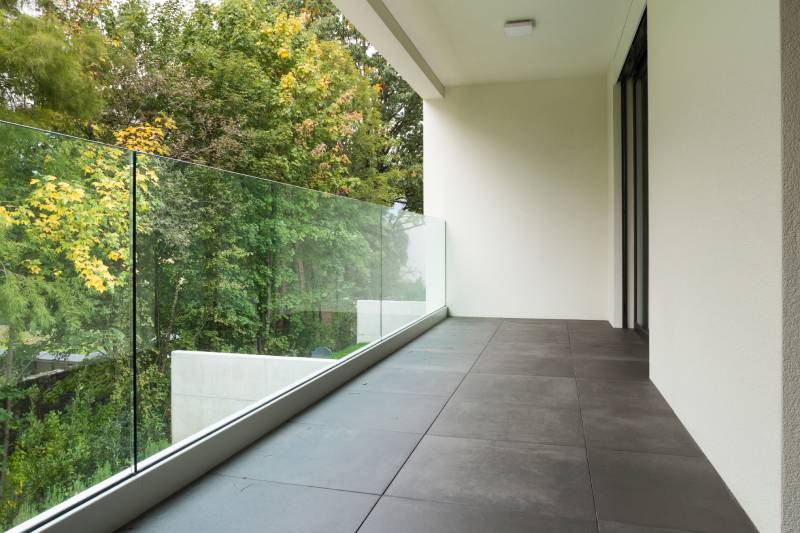
Plexiglass or strong shatterproof glass is an option for owners whose dogs like to chew or who are big and strong enough to potentially break netting. However, this is a more expensive option as you have to get the glass measured to your balcony to ensure a proper fit; if the glass has any corners sticking out, it could easily cause injury.
This is also a more permanent option, and plexiglass will need to be fixed firmly to your balcony, if you’re renting your property, some landlords may not allow this.
Still, it’s an excellent option for those who can place it, as it will be challenging for dogs to break through, if not impossible, and it’s an attractive option that allows dogs to still see through out onto the street.
- Attractive
- Strong
- Allows your dog to see the view
- Expensive
- Is an almost permanent option
3. Bamboo Fence

Bamboo fences are another attractive option and are popular for those who can’t use plexiglass as a permanent option but need something slightly stronger than netting.
The fence can be attached to a balcony using cable ties. However, check wear and tear daily, as determined dogs may be able to chew through the cable ties or the bamboo itself (which can present the problem of not only having a hole in your new balcony railing cover but also potentially causing injury to your pup).
If your dog isn’t a chewer, this may be the perfect option as it’s relatively inexpensive, particularly if installed yourself. Bamboo is a good option even for smaller dogs since they won’t be able to get through the gaps in the bamboo.
- Attractive
- Inexpensive (particularly if DIY)
- Can be removed if needed
- Not suitable for strong dogs or dogs who like to chew
4. Lattice Fence
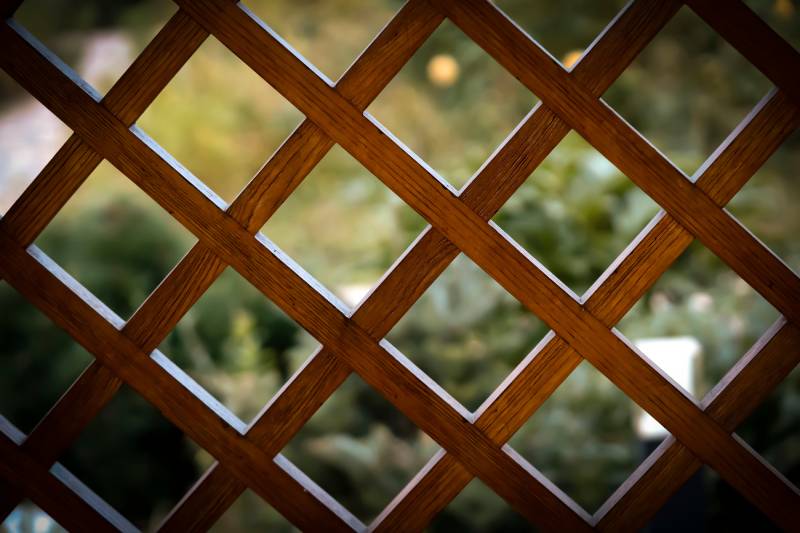
A lattice fence is another option for those who need something substantial to keep their dogs safe and can be the perfect option for those who want something that looks elegant and can be bought from a store with no assembly required.
A well-made lattice fence looks beautiful and will keep large dogs safe on your balcony, allowing them to see through the lattice bars into the area below. However, because there are gaps in the lattice, this fence won’t be suitable for small dogs who may be able to fit through the holes and the balcony bars.
Although lattice fences can be DIY, we recommend purchasing one to ensure stability and strength. Lattice fences are not permanent and can be affixed with cable ties; just make sure to check the cable ties daily for wear and tear.
- Looks good
- Can be bought ready-made or DIY
- Inexpensive
- Strong
- Not suitable for small dogs who may be able to fit through the gaps
5. Chicken Wire
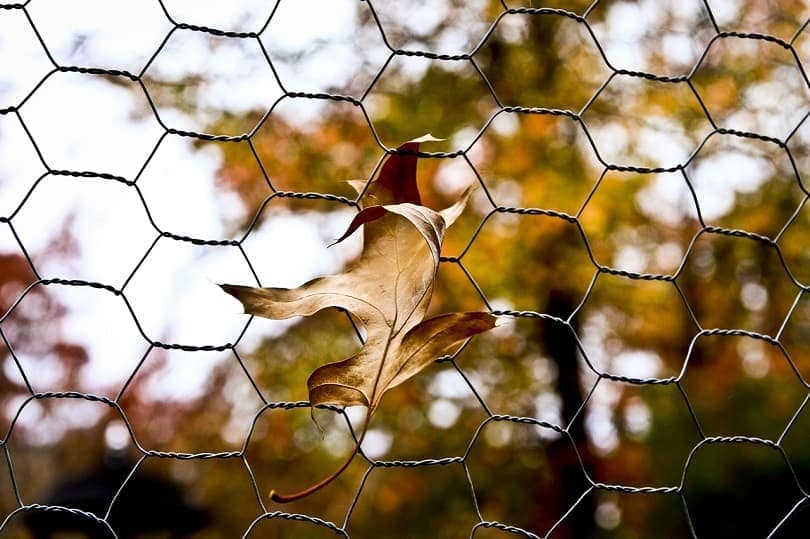
Cheap, cheerful, and very effective, thin chicken wire can be the solution if you have a strong and determined dog, but you don’t want to block the view from your balcony and can’t install plexiglass.
Chicken wire may not be the prettiest of balcony railing covers, but it does the job and performs well. It’s durable and waterproof, and even the strongest dog won’t be able to break through it. Make sure it’s completely affixed to your railings, and check for any damage as often as you can, as chicken wire isn’t indestructible.
- Cheap
- Strong
- Allows air through and allows your dog to look out
- Not the prettiest of balcony railing covers
- Needs firm affixing to your balcony
6. Collar Bumpers
The Collar bumper is something different; you put on it your dog rather than the balcony railings themselves. The collar bumper can be attached to your dog’s neck with a Velcro strap or fastened to your dog’s collar. Collar bumpers ensure your dog can’t put its head through the balcony railing bars, as it will widen your dog’s neck, meaning it can’t get through the bars.
They are also relatively inexpensive and quick to put on, so you can feel good about letting your dog onto the balcony without worrying about them getting through the bars. However, your dog may feel uncomfortable if you leave them in a collar bumper for any period, so they shouldn’t be worn for too long, and they may not suit all dogs since they have to be fitted correctly.
- Inexpensive
- Suits all dogs
- Easy to use
- Has to be fitted correctly
- Cannot be worn for an extended period
7. Adjust the Height of the Railings
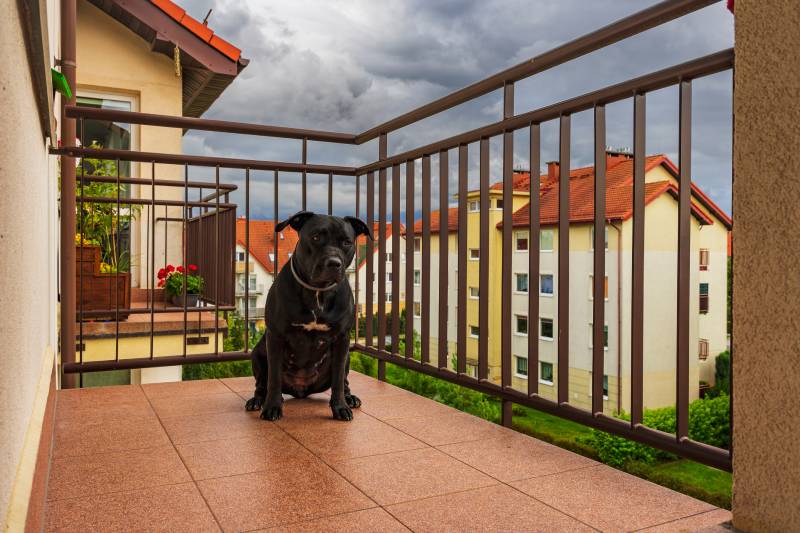
If you own your home or get permission from your landlord, adjusting the height of the railings may be an option for you. Many balcony railings have bars that are close enough together that dogs cannot get their heads through or the rest of their bodies.
However, some of these railings won’t be tall enough, and acrobatic dogs may be able to jump over them. If adjusting the height of the bars by adding extra sections beneath is an option, it may completely fix a problem (particularly if you’re staying in the property long-term).
- Permanent fix to the problem
- Looks just like your ordinary railings
- Works for all breeds and sizes of dog
- Expensive
- Has to be done by a builder or contractor
- Can’t be removed once affixed
8. Consider a Strong Privacy Screen

Privacy screens can be made of many materials, commonly bamboo, wood, or fabric. The good thing about privacy screens is that they come in many colors, shapes, and sizes, so you’ll be able to find one that fits the aesthetic of your home and the dimensions of your balcony.
Finding one that is strong, sturdy, and above all well weighted can help to keep your dog safe on the patio, particularly if you’re always out there with them and they’re not on their own.
Strong wooden privacy screens can be perfect for this; however, most of them will not be able to be attached to the balcony railing, so you would need to put them out every time your dog is on the balcony. In addition, you would likely need to stay with them just in case they get their noses around the privacy screen between the bars.
- Easy to use
- Many options and styles
- Dogs should be supervised at all times as they are usually not affixed to railings
- Can be expensive if made from expensive materials
9. Move Furniture Well Away From Railings

Some dogs are very clever, and keeping any furniture, such as chairs, tables, or couches, away from your balcony railings can help to prevent your dog from being able to climb up and over them.
However, they may learn how to push the furniture against the railing so they can climb up and have a better look over it or jump from the furniture itself. It’s best to get furniture that can be heavily weighed down, affixed to the floor, and positioned or moved away from your balcony railings. Your dog will not be tempted to stand on the back of the couch to look over the railing at the dog on the ground.
- Quick and easy solution
- Does not require purchases
- May not work if your dog is determined
- Might need additional measures
10. Check the Railings Themselves for Safety

The last tip is to check the railings for any safety problems daily if you can. Issues such as plexiglass cracking, the breakage of bars, pointed bits of metal, wood, or plastic that your dog might hurt themselves on, and weak points within the structure should be checked regularly.
- No expenditure needed
- Quick and easy
- It gives you peace of mind
- It may need to be fixed if problems found
- May require additional safety measures
Can I Leave My Dog on The Balcony?
Dogs should never be left on a balcony for any amount of time if you’re not supervising them. Leaving them outside is, in fact, illegal in some places, such as in Canada, where leaving a dog on a balcony is considered animal cruelty. You may think that because the balcony is covered and your dog has food and water, they have adequate shelter, but you couldn’t be more wrong.
Most balconies have hard floors, and the sun can be easily reflected off them, leaving your dog at the mercy of heat stroke. The same goes for cold climates since your balcony will not protect your dog from cold wind or rain. The other obvious issue of leaving your dog on your balcony for any time alone is that they could die if they fall off it. So, it’s best not to let your dog out onto the balcony unless you’re with them at all times.
Conclusion
We hope you found this list of 10 tips to completely dog-proof your balcony useful, as there’s a delicate balance between finding something that looks amazing, works very well, and can be incorporated into your property.
Whether you decide to DIY or buy a ready-made balcony cover for your pup, we hope you found a solution from our list and can enjoy your balcony with your dog for as long as possible.
Featured Image Credit: Daniel Malinowski, Shutterstock
Contents
- The 10 Tips on How to Dog Proof a Balcony
- 1. Netting for Your Balcony
- 2. Plexiglass or Strong, Shatterproof Glass Panels
- 3. Bamboo Fence
- 4. Lattice Fence
- 5. Chicken Wire
- 6. Collar Bumpers
- 7. Adjust the Height of the Railings
- 8. Consider a Strong Privacy Screen
- 9. Move Furniture Well Away From Railings
- 10. Check the Railings Themselves for Safety
- Can I Leave My Dog on The Balcony?
- Conclusion

